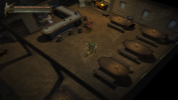Everything capable of outputting video has exceptions to the rule, I have seen the discussion go around in circles about how much VRAM was required for higher resolutions and the PS2 effectively not having enough. Obviously the PS2, like all systems, is capable of rendering scenes in multiple passes. I cited the only "source" I could recover from another forum. The concept presented there, and by you
in another PS2 thread here, is that the PS2 can render in "tiles" thanks to its huge bandwidth in order to get a single screen at a higher resolution. That has not been explained clearly in anything I can find. If I recall the "height buffer" comment on page 13 in
Sony's How Far Have We Got document is referring to this as well as the person who may have worked for Criteron.
It isn't a new concept for rendering, but the PS2 seems to be especially suited for multipass rendering. What I have not seen discussed is whether the PS2's VUs "streaming" polygons on top of polygons for multipass-like effects had to be dropped if the whole scene had to be rendered in steps for a super sampling solution. Either way, I think it is equally clear that the way the PS2 does things does not equate to how the Dreamcast, Xbox, Gamecube or PC graphics cards render. This was my main point.
Secondarily to that, I think PS2 games rendering at lower resolutions is obvious even when it upscales to a higher output resolution. When I do a search currently on the Snowblind games, the only thing I can find easily is emulators having a hard time with them. Obviously these games were rendering in a way most PS2 games do not. I am not claiming they aren't super sampled in a way, because I do not know.

